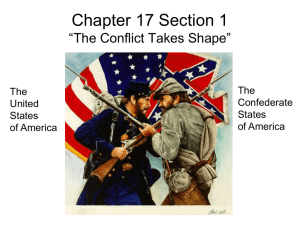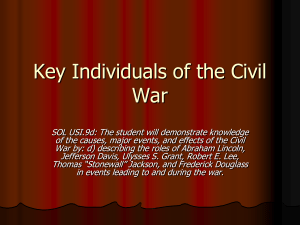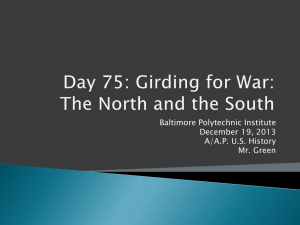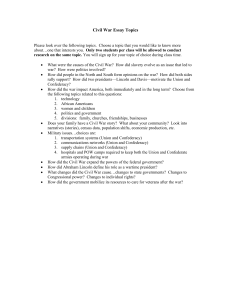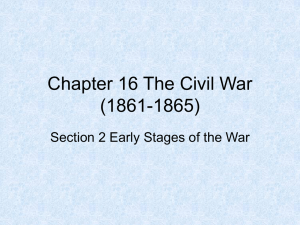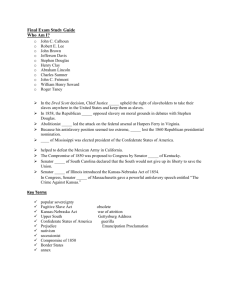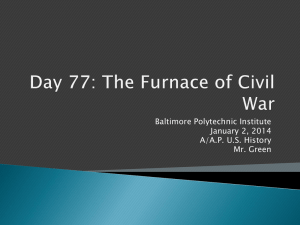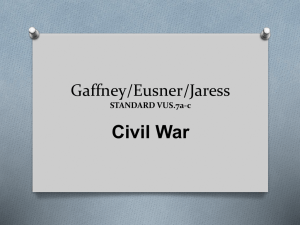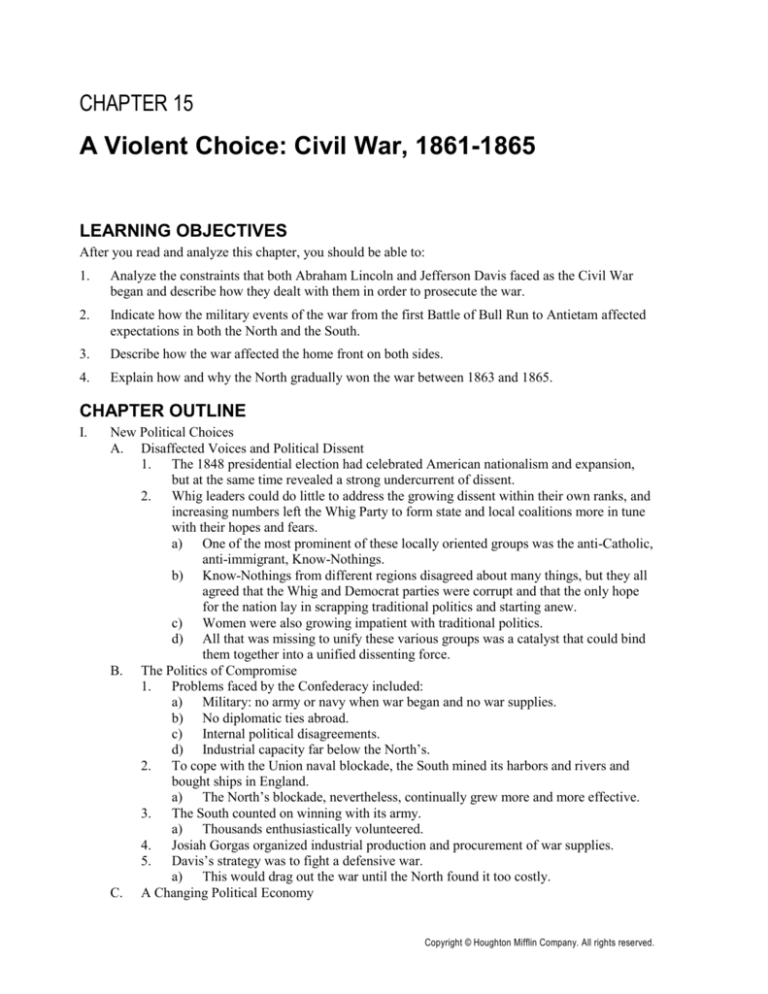
CHAPTER 15
A Violent Choice: Civil War, 1861-1865
LEARNING OBJECTIVES
After you read and analyze this chapter, you should be able to:
1.
Analyze the constraints that both Abraham Lincoln and Jefferson Davis faced as the Civil War
began and describe how they dealt with them in order to prosecute the war.
2.
Indicate how the military events of the war from the first Battle of Bull Run to Antietam affected
expectations in both the North and the South.
3.
Describe how the war affected the home front on both sides.
4.
Explain how and why the North gradually won the war between 1863 and 1865.
CHAPTER OUTLINE
I.
New Political Choices
A. Disaffected Voices and Political Dissent
1. The 1848 presidential election had celebrated American nationalism and expansion,
but at the same time revealed a strong undercurrent of dissent.
2. Whig leaders could do little to address the growing dissent within their own ranks, and
increasing numbers left the Whig Party to form state and local coalitions more in tune
with their hopes and fears.
a) One of the most prominent of these locally oriented groups was the anti-Catholic,
anti-immigrant, Know-Nothings.
b) Know-Nothings from different regions disagreed about many things, but they all
agreed that the Whig and Democrat parties were corrupt and that the only hope
for the nation lay in scrapping traditional politics and starting anew.
c) Women were also growing impatient with traditional politics.
d) All that was missing to unify these various groups was a catalyst that could bind
them together into a unified dissenting force.
B. The Politics of Compromise
1. Problems faced by the Confederacy included:
a) Military: no army or navy when war began and no war supplies.
b) No diplomatic ties abroad.
c) Internal political disagreements.
d) Industrial capacity far below the North’s.
2. To cope with the Union naval blockade, the South mined its harbors and rivers and
bought ships in England.
a) The North’s blockade, nevertheless, continually grew more and more effective.
3. The South counted on winning with its army.
a) Thousands enthusiastically volunteered.
4. Josiah Gorgas organized industrial production and procurement of war supplies.
5. Davis’s strategy was to fight a defensive war.
a) This would drag out the war until the North found it too costly.
C. A Changing Political Economy
Copyright © Houghton Mifflin Company. All rights reserved.
Chapter 15: A Violent Choice: Civil War, 1861-1865
1.
II.
173
The South sought international recognition, especially by Britain.
a) Britain did not extend recognition but did grant the South belligerent status.
2. The North alienated the British in the Trent affair.
a) The North’s diplomats appeased Britain and prevented any break between the
two.
D. The Union’s First Attack
1. In the Battle of Bull Run (won by the South), Union forces panicked and fled.
a) The South felt reassured of ultimate victory; the North realized that the war
would be long and drawn out.
b) Lincoln relieved the aged Scott as chief general and appointed McClellan in his
place.
2. McClellan organized and trained the army.
a) He was reluctant, however, to attack; the war in the East, therefore, ground to a
halt.
From Bull Run to Antietam
A. The War in the West
1. In Missouri, both sides fought each other in guerrilla fashion for the duration of the
war.
2. In New Mexico, an invading Texan force won victories but, lacking supplies, was
forced to return to Texas.
3. Implications of the Civil War for Native Americans:
a) Indian uprisings occurred, as federal troops were sent to fight in the South; the
Santee Sioux killed over 800 settlers in Minnesota.
b) The South established alliances with several Indian tribes, but they did not prove
helpful to the southern war effort.
c) Cherokee Stand Watie became a Confederate general.
d) Indians also allied with the North.
B. Struggle for the Mississippi
1. The North gained control of the upper and lower Mississippi.
a) Grant brought Kentucky and most of Tennessee under control.
b) The Battle of Shiloh demonstrated that the war’s cost to life would be horrific.
c) Admiral Farragut captured New Orleans.
d) The Union advance stalled at Vicksburg.
C. Lee’s Aggressive Defense of Virginia
1. The South’s main military task was to defend its capital at Richmond, Virginia.
a) Lincoln needed military victories in the East for political reasons.
b) The outcome of the naval battle between the Monitor and the Merrimac made
inland Richmond vulnerable.
2. McClellan undertook the peninsular campaign in order to capture Richmond.
a) Because of his indecisiveness, Confederate forces under Lee were able to retreat
to Richmond.
b) Jackson led a diversionary campaign toward Washington.
c) Lee then attacked McClellan and forced him to abandon the Peninsular
Campaign.
D. Lee’s Invasion of Maryland
1. Lee invaded the North in Maryland.
a) Union forces discovered his plans, and Lee began to withdraw from Maryland.
b) His army clashed with McClellan’s at Antietam, the bloodiest, single-day
engagement of the war.
c) He retreated to Virginia, but McClellan’s indecisiveness again prevented
destruction of Lee’s army.
Copyright © Houghton Mifflin Company. All rights reserved.
174
Chapter 15: A Violent Choice: Civil War, 1861-1865
E.
Diplomacy and the Politics of Emancipation
1. Despite Confederate efforts, Britain maintained its neutrality.
a) The North’s ambassador was extremely effective.
b) Britain had a cotton surplus in hand.
c) The Confederate defeat at Antietam confirmed the British policy of neutrality.
2. Under pressure from Radical Republicans, Lincoln drew up the Emancipation
Proclamation.
a) He released it after the victory at Antietam.
b) It did not actually free any slaves.
c) Abolitionists, nonetheless, hailed it.
III. The Human Dimensions of War
A. Instituting the Draft
1. Both armies by the end of 1862 faced a serious lack of manpower and could no longer
rely on volunteers alone.
a) The Union enacted the Conscription Act, but wealthy individuals could buy
exemptions or hire replacements.
b) The South’s compulsory draft also allowed for exemptions (the Twenty-Negro
Law).
2. In both sections, deep resentment ensued.
a) In New York City, the federal army had to suppress violent rioting against the
draft.
b) In the South, draftees did not report for duty.
B. Wartime Economy in the North and South
1. The North’s industry and economy expanded as a result of the war.
a) Government assistance (railroad subsidies, higher tariffs, and the Homestead Act)
underwrote economic growth.
b) Unsafe financial practices—greenbacks and bond sales—set the stage for postwar
problems.
2. The southern economy lacked an industrial base.
a) The government offered loans to stimulate greater industrial production for the
war.
b) It also printed paper money not backed by specie.
3. The South’s meager industrial base hampered its war effort.
a) War supplies were always too small.
b) Hunger was widespread, even in the army.
c) The Union blockade, the fall of New Orleans, and the loss of the Mississippi
made the southern economy worse.
C. Women in Two Nations at War
1. Women in both sections assumed greater responsibilities.
a) With men away at war, women were in charge of farms and businesses and
worked outside the home.
2. Women participated in the war as nurses, scouts, couriers, and spies, and over 400
served as soldiers.
D. Free Blacks, Slaves, and War
1. More than 200,000 blacks served in the Union armed forces.
a) Free blacks were at first rejected for service but later allowed to enlist.
b) Commanders accepted runaway slaves as laborers (“contrabands”).
c) African American soldiers suffered various kinds of discrimination: lower pay,
segregation, and no opportunities to serve as officers.
d) Few were allowed to fight, but they won respect when they did.
e) Confederates committed atrocities rather than take blacks as prisoners.
Copyright © Houghton Mifflin Company. All rights reserved.
Chapter 15: A Violent Choice: Civil War, 1861-1865
175
2. The South relied on slaves in food production, military labor, and war-related industry.
Life and Death at the Front
1. Though life in camp was tedious, it could be nearly as dangerous as time spent on the
battlefield.
a) Problems with supplying safe drinking water and disposing of waste were
constant.
b) Disease like dysentery and typhoid fever frequently swept through unsanitary
camps.
c) Small pox, pneumonia, and malarial fevers passed rapidly from person to person
in the overcrowded conditions.
2. In June 1861, Lincoln responded by creating the United States Sanitary Commission.
3. Nurses on both sides showed bravery and devotion.
4. Many surgeons at the front lines could do little more than amputate limbs to save lives.
5. Conditions were even worse in prison camps.
IV. Waging Total War
A. Lincoln’s Generals and Southern Successes
1. The Battle of Chancellorsville was a loss for both sides: the North lost the battle and
the South lost Stonewall Jackson.
2. The summer of 1863 saw two critical Union wins.
a) Grant took Vicksburg, thereby gaining control of the entire Mississippi.
b) Lee’s army was defeated at Gettysburg.
3. Lincoln turned to Grant.
a) Meade (like all the northern generals who preceded him) proved to be indecisive,
not pursuing Lee’s retreating army after Gettysburg.
B. Grant, Sherman, and the Invention of Total War
1. Lincoln appointed Grant general in chief.
a) He was willing to practice total war, to tolerate enormous loss of life to win, and
to move decisively.
b) Sherman, likewise, practiced total war.
2. Grant took command of the army in Virginia.
a) Driving toward Richmond, the Union army sustained terrible losses at the
Wilderness, Spotsylvania, and Cold Harbor.
b) Lee occupied Petersburg and blocked the way to Richmond; a ten-month siege by
the Union army ensued.
C. The Election of 1864 and Sherman’s March to the Sea
1. The Republican Party was divided as the election approached.
a) Radical Republicans nominated Fremont for president; they wanted more
vindictive treatment of the South.
b) The moderate wing (“Union Party”) nominated Lincoln.
2. The Democrats nominated McClellan.
a) Their platform called for immediate peace.
3. Union victories enabled Lincoln to win reelection.
a) Sherman captured Atlanta.
b) Sheridan drove the South’s army out of the Shenandoah Valley.
c) The Radical Republicans rallied behind Lincoln.
4. Sherman began his March to the Sea.
a) He devastated the South from Atlanta to Savannah and then moved north into
South Carolina.
b) Confederate forces formed up in North Carolina under Johnston, to block
Sherman’s further advance toward Virginia.
D. The Fall of Lee and Lincoln
E.
Copyright © Houghton Mifflin Company. All rights reserved.
176
Chapter 15: A Violent Choice: Civil War, 1861-1865
1.
2.
3.
Lee abandoned Petersburg and marched west, hoping to then go south to join Johnston.
a) Under constant pressure from the Union army, Lee surrendered his army to Grant
at Appomattox.
Lincoln was assassinated several days later.
Despite Lee’s surrender, some fighting continued.
IDENTIFICATIONS
Identify the following items and explain the significance of each. While you should include any
relevant historical terms, using your own words to write these definitions will help you better remember
these items for your next exam.
1.
Mary Ashton Rice Livermore
2.
Calvinism
3.
free state
4.
U.S. Sanitary Commission
5.
insurrection
6.
rebellion
7.
anaconda plan
8.
Radical Republicans
9.
Thaddeus Stevens
10. revenue cutter
11. pig iron
12. ordnance
13. percussion cap
14. belligerent
15. Bull Run
16. Thomas J. Jackson
17. George B. McClellan
18. Army of the Potomac
19. John Ross
20. Ulysses S. Grant
21. William Tecumseh Sherman
22. Battle of Shiloh
23. Vicksburg
24. Peninsular Campaign
25. Second Battle of Bull Run
26. Antietam Creek
27. Fredericksburg
Copyright © Houghton Mifflin Company. All rights reserved.
Chapter 15: A Violent Choice: Civil War, 1861-1865
28. deploy
29. Horace Greeley
30. Emancipation Proclamation
31. Conscription Act
32. hang in effigy
33. Twenty-Negro Law
34. Homestead Act
35. greenbacks
36. 54th Massachusetts
37. John Wilkes Booth
38. Clara Barton
39. Andersonville
40. Chancellorsville
41. Gettysburg
42. Port Hudson
43. total war
44. The Wilderness
45. Cold Harbor
46. vanguard
47. Andrew Johnson
48. Copperheads
49. March to the Sea
MULTIPLE-CHOICE QUESTIONS
Select the correct answer.
1.
2.
The factors that contributed to the ultimate defeat of the Confederacy included
a.
epidemics that ravaged the civilian population.
b. its small transportation network.
c.
slave uprisings.
d. All of these
The South’s primary hope in foreign affairs was to
a.
win British recognition.
b. spread southward into Mexico and Central America.
c.
convince all European nations to break off relations with the North.
d. create an alliance with Canada and thereby surround the North.
Copyright © Houghton Mifflin Company. All rights reserved.
177
178
Chapter 15: A Violent Choice: Civil War, 1861-1865
3.
The anaconda plan, drafted by General Winfield Scott, called for
a.
immediate capture of the Confederate capital.
b. an amphibious assault on New Orleans, Mobile, and Charleston.
c.
a blockade of southern ports and the control of the Mississippi River.
d. a massive land war in the South.
4. The Trent affair early in the war produced a diplomatic crisis when
a.
a British ship was sunk by Union forces.
b. British ships sank a Confederate vessel.
c.
Union forces seized Confederate diplomats from a British ship.
d. Confederate forces sought a military alliance with British forces.
5. Until he selected Grant as general in chief, Lincoln’s primary problem with his generals was their
a.
entry into battle even when unprepared.
b. aspirations for political office.
c.
excessive age and inexperience.
d. inability to move decisively.
6. The political difficulties faced by Lincoln included
a.
opposition within his party from the Radical Republican wing.
b. the inability of the Republican Party to command the respect of the voters because it was so
new.
c.
amateur, incompetent cabinet officers.
d. the soldiers’ vote—and their families back home.
7. Hoping to win military victory, the Confederacy counted on
a.
a high rate of desertions in the Union army.
b. the superior generalship of Robert E. Lee.
c.
a larger navy than the North’s.
d. intervention against the North by a coalition of European nations.
8. The Radical Republicans expressed disappointment with Abraham Lincoln because
a.
he refused to appoint Ulysses S. Grant to an important command.
b. Lee triumphed at the Battle of Gettysburg.
c.
he failed to prevent British recognition of southern independence.
d. for the first two years of the war he did nothing to end slavery.
9. The Battle of Antietam proved to be more than just a military loss for the South because
a.
desertions from its army skyrocketed.
b. it ended any remaining hopes of British diplomatic recognition.
c.
civilian morale plunged, causing many to desert the southern cause.
d. northerners rushed to join the army in larger numbers than ever before.
10. As a result of the Emancipation Proclamation,
a.
slave uprisings broke out all over the Deep South.
b. Lincoln almost lost renomination for the presidency in 1864.
c.
all remaining slaves in the border states were freed.
d. not a single slave actually went free when it was announced.
11. Virginia was of great military and political importance because
a.
it was Robert E. Lee’s home state.
b. many of its inhabitants secretly opposed the Confederacy and were eager to rejoin the
Union.
c.
of its symbolism as the state where George Washington and Thomas Jefferson had lived.
d. Richmond, the Confederate capital, was located there.
Copyright © Houghton Mifflin Company. All rights reserved.
Chapter 15: A Violent Choice: Civil War, 1861-1865
179
12. The New York City race riots of 1863 were chiefly the result of frustrations traceable to
a.
the Conscription Act.
b. police brutality.
c.
Union defeats on the battlefield.
d. immigration policy.
13. African Americans who enlisted in the North’s army
a.
usually endured discrimination.
b. had to pay to do so.
c.
became extremely unpopular in their communities.
d. were promised land in the South.
14. Lincoln was able to overcome political opposition in 1864 to win reelection as president because
of
a.
military victories.
b. rumors that the South was about to surrender.
c.
British foreign aid.
d. a great wartime religious revival.
15. Which of the following statements is not true of the Civil War?
a.
Political disagreements shadowed both Abraham Lincoln and Jefferson Davis.
b. Lincoln’s initial war aims included the end of slavery in the South.
c.
The South’s industrial capacity was inferior to that of the North.
d. The South believed that it would be in a better position once Britain recognized it as an
independent nation.
ESSAY QUESTIONS
1.
War often reveals the strains that lie WITHIN a society. Do you think that this statement is
applicable to the North and South during the Civil War?
DEVELOPING YOUR ANSWER: The Conscription Act surely exposed strains within northern
society. You should accordingly analyze the New York City draft riots in terms of what they
revealed about the tensions among differing social classes and ethnic groups in the North.
The South’s version of the draft—the Twenty-Negro Law—revealed similar strains between rich
and poor; draft avoidance resulted. (You might also refer to material in Chapter 14, which reveals
that strains were apparent even earlier in the important state of Virginia. There, a “secessionist”
movement of Unionists who opposed the slaveholding class resulted in the creation of a new state,
West Virginia.)
The war also bared the feelings of many northerners toward African Americans. Your essay
should include discussion of opposition to permitting them to serve in the army when the war
began. As the conflict dragged on, African Americans were eventually permitted to join, but they
were relegated to lowly positions and forced to endure many indignities. Only after the passage of
still more time were some permitted to fight.
2.
Despite the North’s overwhelming superiority in population, industry, and transportation, as well
as its success in preventing Britain from recognizing the South, it took four full years to win the
war. What factors, in your opinion, account for the North’s inability to win for so long?
DEVELOPING YOUR ANSWER: Perhaps the most important reason was the quality of military
leadership on both sides. Lee was by all accounts the country’s most brilliant general, while
Stonewall Jackson repeatedly demonstrated the kind of daring and bravado that win victories. The
North’s generals, on the other hand, while competent, were slow to move. They were indecisive,
usually failing to follow up victories by pursuing escaping southern armies in order to destroy
Copyright © Houghton Mifflin Company. All rights reserved.
180
Chapter 15: A Violent Choice: Civil War, 1861-1865
them. Concrete examples that you should discuss include McClellan’s repeated failure to attack
and the disappointing aftermath of the North’s victories at Antietam and Gettysburg.
The North finally began to turn the tide when Lincoln found a new kind of general, one who was
willing to wage total war, to ruthlessly crush the opponent, and to absorb any and all costs in order
to win. Grant and Sherman, of course, were the new-style northern generals who by dint of this
approach eventually overwhelmed even the brilliant Lee.
A second factor that slowed the North’s victory was Jefferson Davis’s decision at the outset to
fight a defensive war. This compelled the North to invade the South. It meant that the North had
to establish supply and communication lines hundreds of miles long, while southern forces could
pull back, feint, parry, and surround—all on home ground.
3.
Discuss the impact of the Civil War on slavery in the South.
DEVELOPING YOUR ANSWER: With the exception of the abolitionists, a distinct minority in
northern society, the North had no interest at the beginning of the war in interfering with slavery
in the South. Lincoln made this quite clear in his first inaugural address.
Eventually, however, Lincoln decided to issue the Emancipation Proclamation, thereby making
the war into one whose purpose was not only to save the Union but also to end slavery in the
South. You should emphasize in your essay, however, that the Emancipation Proclamation
technically did not free a single person when it took effect, for it applied only to areas still in
rebellion. It was only after such areas were captured by the North that the slaves therein became
free.
Slavery, therefore, continued in areas that had not rebelled (the border states) and that had been
recaptured prior to the proclamation’s taking effect. Ending slavery in those regions would have to
wait until after the Civil War.
Some slaves in the South ran from their masters (thereby gaining their freedom) to Union army
lines, where, as “contrabands,” they worked for the North.
MAP EXERCISES
Utilize the opening map in Chapter 15 for the following projects.
1.
Imagine that you are a northern general at the beginning of 1861 and design your own military
plan to subdue the South. Try not to be influenced by what you already know of northern strategy
and operations during the Civil War. (After completing this exercise, you might wish to examine
the Chapter 15 maps in your textbook to compare your military plan with what actually occurred.)
2.
Imagine that you are a southern general at the beginning of 1861 and design a military plan to
invade the North in order to stun it into accepting southern independence as a fact. Assume that
this might be possible should President Davis reverse his decision to fight a defensive war. Can
you formulate a plan different from General Lee’s invasions of Maryland in 1862 and
Pennsylvania in 1863?
INDIVIDUAL CHOICES
Mary Ashton Rice Livermore
To answer the following questions, consult the Individual Choices section at the beginning of the
chapter.
1.
Briefly describe Mary Ashton Rice Livermore’s background. What, if anything, about her
background gives an indication of her future activities during the Civil War?
Copyright © Houghton Mifflin Company. All rights reserved.
Chapter 15: A Violent Choice: Civil War, 1861-1865
2.
Why were events in Kansas so critical in the years prior to the Civil War?
3.
What did Livermore do once war broke out in 1861? What impact did she have?
4.
What were some of the nationwide effects of Livermore’s efforts?
181
INDIVIDUAL VOICES
Examining a Primary Source: Mary Ashton Rice Livermore Depicts
Women’s War Efforts
To answer the following questions, consult the Individual Choices section at the beginning of the
chapter.
1.
How does Livermore characterize the differences between men and women in terms of their
response to the appeals of war? What does this reflect about general attitudes toward gender in
mid-nineteenth-century America?
2.
What is Livermore suggesting here about the role of women during wartime? Does she portray
this role as inferior, superior, or equal to that played by men?
3.
In light of this eloquent description of women’s efforts during the war, what would Livermore
probably suggest about appropriate peacetime employment for women? Would you characterize
this as a “feminist” or a “traditionalist” statement? What leads you to this conclusion?
RUBRIC: Research the efforts of women during the Civil War and use the resulting information to
complete the rubric below.
WOMEN IN THE CIVIL
WAR
BACKGROUND
ACTIVITIES
IMPACT
ANSWERS TO MULTIPLE-CHOICE QUESTIONS
1.
b.
The South lacked an adequate transport system, mirrored by its minute production of
locomotives. See pages 425-426.
a.
The South’s many problems in fighting the war did not include epidemics.
c.
In fact, slaves comprised a large part of the labor force for the war effort.
d.
Only 1b is correct.
Copyright © Houghton Mifflin Company. All rights reserved.
182
2.
Chapter 15: A Violent Choice: Civil War, 1861-1865
a.
b.
See pages 426-427.
It had no such ambitions in its foreign policy. See pages 426-427.
c.
The South’s fundamental or first need was to win recognition by foreign powers. See pages
426-427.
d.
3.
It hoped to win British recognition. (Canada was a British possession.) See pages 426-427.
c.
The idea was to split the Confederacy in two and to cut it off from contact with the outside
world, thereby causing economic problems. See page 428.
a.
The anaconda plan focused on thrusting down the Mississippi River and on blockading the
South’s ports; the capital at Richmond, Virginia, was not a port, and it was far from the
Mississippi. See page 428.
4.
b.
The plan prescribed only a naval blockade of such ports. See page 428.
d.
See page 428.
c.
a.
See page 431.
The British merchant ship called the Trent was stopped by Union forces. See page 431.
b. A Union ship stopped the British Trent at sea and removed Confederate diplomats sailing on
it. See page 431.
d. The Trent affair was a naval incident involving a Union vessel and a British merchant ship.
See page 431.
5.
d.
McClellan and others repeatedly failed to attack or to follow up after a successful
engagement with Confederate forces. They repeatedly demonstrated their reluctance to go on the
offensive. See pages 427-428, 431-433, and 445-447.
a.
Lincoln’s generals did not act unwisely. See pages 427-428, 431-433, and 445-447.
b. Although McClellan was nominated by the Democrats and ran for president in 1864, his
entry into politics came after Lincoln had ousted him from command. See pages 449-451.
c.
6.
The only one who was elderly was General Winfield Scott. See page 427.
a.
They actually considered nominating another man for the presidency in 1864. See pages
447-448.
b. The Republicans’ newness was not their problem; internal division within their party was.
See pages 447-478.
c.
There is no evidence for this. See pages 447-478.
d. In the election of 1864, Lincoln probably did not have to worry about the soldiers’ vote or
that of their families after the North’s military victories at Atlanta and in the Shenandoah Valley.
The victories helped Lincoln win reelection in 1864. See pages 447-448.
Copyright © Houghton Mifflin Company. All rights reserved.
Chapter 15: A Violent Choice: Civil War, 1861-1865
7.
183
b.
Time and again, Lee demonstrated his brilliance as a general. See, for example, pages 435437.
a.
Although desertions were a problem in the Union army, the Confederacy could not count
upon them for victory because desertions also depleted their own army. See pages 429-431.
c.
When war began, the Confederacy did not even have a navy. Moreover, the anaconda plan
counted on the North’s naval superiority. See page 429.
d. At best, the Confederacy hoped only for recognition by foreign nations, especially Britain.
See pages 430-431.
8.
d.
See pages 428 and 437.
a.
Their opposition arose because defeat of the South was taking so long, but mainly because
Lincoln did not move against slavery. See pages 447-448.
9.
b.
Lee lost at Gettysburg. See page 446.
c.
Ambassador Adams brilliantly prevented British recognition of the South. See page 437.
b.
Lee’s failure at Antietam had this effect. See pages 434-437.
a.
See pages 434-437.
c.
There is no evidence that the South’s loss at Antietam led to this. See pages 434-437.
d. On the contrary, manpower needs in the army remained a problem even after Antietam
(September 1862), forcing institution of a draft (March 1863). See pages 434-437.
10. d.
It applied only to slaves in areas still in rebellion against the Union, where the North could
not enforce it. It did not apply to slaves in the border states or to those in areas already recaptured
by the North. See page 438.
a.
It had no such impact. See page 438.
b. Lincoln’s challenge to win the nomination in 1864 had to do with his reluctance to punish
the South. See pages 438 and 449-450.
c.
11. d.
The Emancipation Proclamation did not apply to the four border states. See page 438.
See pages 435-436.
a.
Although Lee came from Virginia, that state’s importance was attributable to the fact that
the Confederacy’s capital was located in it. See pages 435-436.
b. Unionists in Virginia seceded from the state and formed the new state of West Virginia, but
this had not prevented Virginia from joining the Confederacy. See pages 416-418.
c.
The fact that it contained the Confederacy’s capital is what gave it its significance. See
pages 435-436.
12. a.
The conscription law angered those who could not afford to purchase exemptions from the
draft. See page 439.
b.
There is no evidence that this was a cause of the riot. See page 439.
c.
There no evidence that Union defeats caused the riot. Furthermore, it began on July 13,
1863, just after the North’s triumphs at Gettysburg and Vicksburg. See pages 445-453.
d.
The riot occurred because of the introduction of the draft. See page 439.
Copyright © Houghton Mifflin Company. All rights reserved.
184
Chapter 15: A Violent Choice: Civil War, 1861-1865
13. a.
See pages 442-443 for the segregation and many other indignities that they endured.
b.
To the contrary, they were sometimes paid (given bonuses) to enlist. See pages 442-443.
c.
There is no evidence for this. See pages 442-443.
d.
There is no evidence for this. See pages 442-443.
14. a.
Victories at Atlanta and in the Shenandoah helped him. See pages 449-451.
b.
There is no evidence of such. See pages 449-451.
c.
The British remained neutral throughout the American conflict.
d.
This never occurred.
15. b.
Because this statement is not true, it is the correct choice. Lincoln’s original war aim was to
return the states that had seceded to the Union; he explicitly excluded the ending of slavery as a
war goal. See pages 426-429.
a.
Because this statement is true, it is not the correct choice. For their respective political
difficulties, see pages 449-453.
c.
Because this statement is true, it is not the correct choice. The North’s industrial capacity
was superior in all respects. See pages 440-441.
d. Because this statement is true, it is not the correct choice. The South sought British
recognition. See pages 430-431.
Copyright © Houghton Mifflin Company. All rights reserved.

